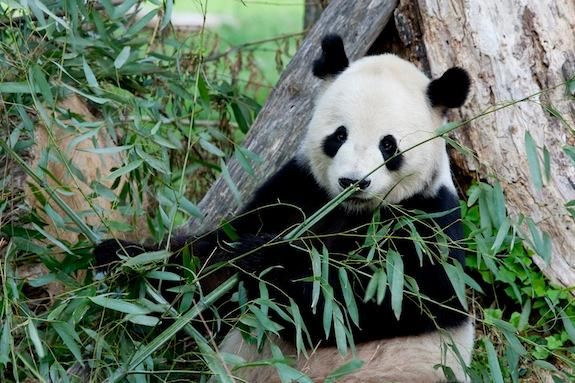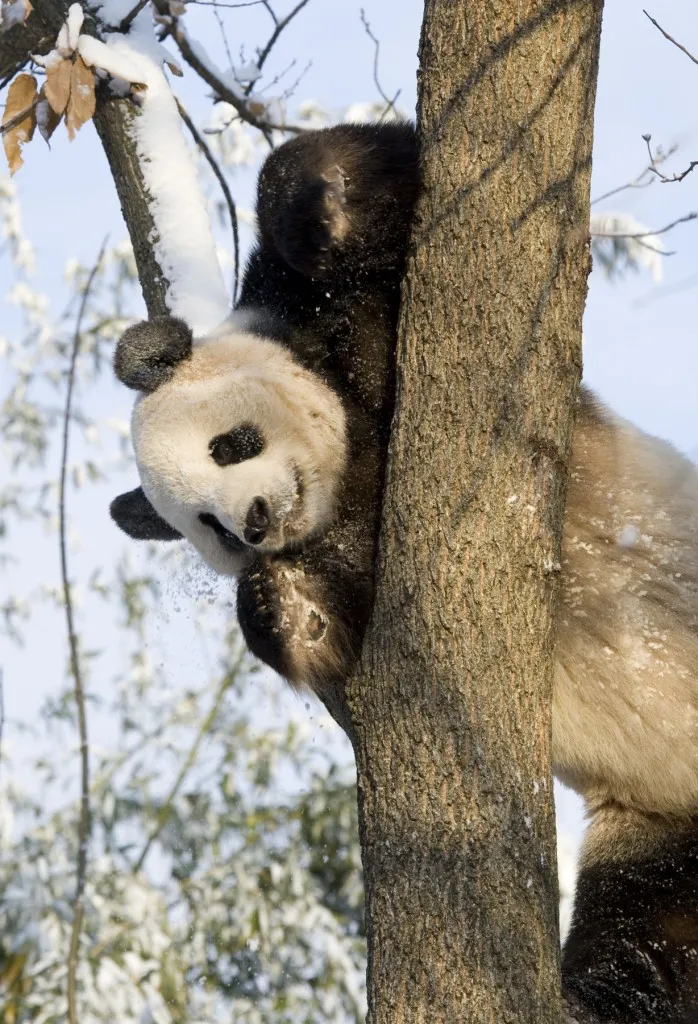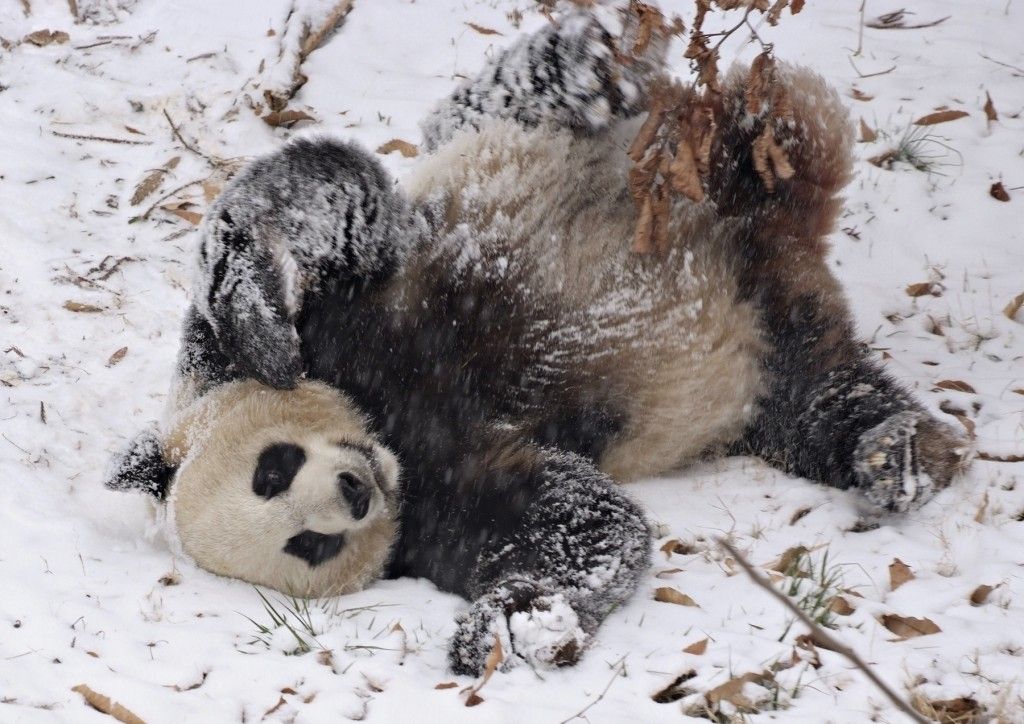How Does Science Help Pandas Make More Panda Babies?
A behind-the-scenes look at the ways the National Zoo assists Washington’s most famous sexually frustrated bear couple
/https://tf-cmsv2-smithsonianmag-media.s3.amazonaws.com/filer/Around-Mall-Pandas-631.jpg)
The National Zoo’s two giant pandas have little interest in each other 11 months of the year. Mei Xiang, 15, and Tian Tian, 16, are solitary creatures, happy to spend most of their days chowing down and napping. But March was mating season. For 30 to 45 days, pandas undergo behavioral and physical changes that prepare them for an annual 24- to 72-hour window in which females ovulate, the only time they can conceive.
Just because they are able to mate, though, doesn’t mean they will. Mei Xiang and Tian Tian are what David Wildt, head of the Center for Species Survival at the National Zoo, calls “behaviorally incompetent.”
“Tian Tian tries really hard, and is very diligent in his duties,” he says, “but he’s just not able to pull Mei Xiang into the proper mating position.”
The pair is not alone. Of pandas in the United States today, only two, Gao Gao and Bai Yun at the San Diego Zoo, have been able to breed naturally. Captive pairs have succeeded elsewhere in the world as well—especially in China, the bears’ native home, where the captive population is much higher—but mating difficulties are still common. Panda’s total population, captive and wild, is about 2,000, so each failed match is a crucial missed opportunity for repopulation.
The species’ future is brighter than these mating difficulties suggest, though. Wildt is part of an international network of American and Chinese specialists—veterinarians, researchers and zookeepers—who have collaborated for years on improving captive panda breeding practices. In recent years, the team has made huge advances in understanding the bears’ biology and behavior, which has inspired new approaches to care that reduce faulty coupling, or even circumvent it.
Their studies are turning the tide. Today, the bears’ captive population is around 350, almost triple what it was 15 years ago.
When Mei Xiang began to ovulate on the last weekend of March, zookeepers closed the David M. Rubenstein Family Giant Panda Habitat to visitors, made sure she and Tian Tian were comfortable, then brought the lustful pair into the same room for the first time since last spring. The two had become rambunctious leading up to the encounter, and spent days staring longingly at one another through the fence that divides their yards. They had hardly touched their bamboo.
Despite the flirtatious fireworks, though—and while it was the seventh year in a row the two had been put together to mate—the two pandas again failed to copulate. As she has in the past, Mei Xiang flopped on her belly like a pancake when she met with Tian Tian—the opposite of good mating posture, which would have her rigid on all fours—and Tian Tian went about his usual routine of stomping around and standing on her, clueless what to do.
After multiple attempts, the keepers ushered the tired pair back to their separate yards.
Panda breeders’ challenge is overcoming unknown variables in the mating process, says Copper Aitken-Palmer, head vet at the Smithsonian Conservation Biology Institute. “There may be some developmental things that we are doing differently under human care, versus what they’re learning in the wild,” she says. Cubs often stay with their mothers for two or more years in the wild, for instance, so they might learn how to breed by watching or listening. Adults may need to mate with an experienced partner first to learn what to do. It’s hard to know for sure, Aitken-Palmer explains, because wild pandas are incredibly hard to observe in their bamboo-filled habitat in China’s southwestern mountains.

The National Zoo compensates for its lack of other pandas to mimic these conditions by preparing Mei Xiang and Tian Tian year-round for mating, both the act itself and the steps leading up to and following it. Since Mei Xiang arrived, she has been trained to receive injections, get blood drawn, milk and lie peacefully during ultrasounds, all without a fuss. (She even rubs the ultrasound gel over herself for her keepers.) The Zoo is trying to teach her to pancake onto a raised platform instead of the ground to make herself more accessible to Tian Tian, and also gives Tian Tian strengthening exercises so one day he might learn to pull her upright.
In China, zoos and breeding centers with a greater number of pandas use similar techniques to encourage coupling, and have begun to test the theory that pandas learn from observation by having cubs attend breeding sessions. On rare occasions, some Asian breeding centers have gone so far as to show their bears videos of other pandas mating—yep, panda porn. There’s no concrete evidence it works, though.
(Josh Groban has his own panda mating technique, but its success also hasn’t been confirmed.)
More than behavioral changes, the most significant improvements in breeding techniques have come at the chemical level. Researchers have developed increasingly accurate measurements of female pandas’ hormone levels and vaginal cell changes, and now are able to pinpoint the exact ideal time frame for a panda’s egg to be fertilized. This new-found accuracy not only dictates the best window to put two pandas together in the same room, but also dramatically improves the success of the practice that allows pairs who cannot figure out how to mate to have cubs anyways: artificial insemination.
“Because pandas’ reproductive activity is so infrequent, they don’t have many opportunities for sexual experimentation and figuring it out,” Wildt says. A panda in heat in the wild may mate with a number of males all competing for her, but those in America’s zoos are stuck with the one they’ve got, regardless of sexual compatibility. Artificial insemination is key to panda breeding, he explains, because it has allowed scientists to overstep the hurdle of sexual compatibility entirely. The technique, which deposits collected semen into a female while she is anesthetized, was “very rudimentary” in the early 2000s, in his words, but took off about seven years ago when scientists began to develop effective ways to freeze and store semen for multiple years and craft more precise tools, like tiny catheters that sneak through a female panda’s cervix to place sperm directly into her uterus.
So far in America, six panda cubs have been produced by artificial insemination, including two from Mei Xiang. That’s one more than the number of the country’s naturally conceived cubs—and as Wildt points out, those cubs all come from the same super-compatible couple in San Diego. (No exact data is available for China’s natural vs. artificial breeding stats, Wildt says, because its zoos often follow successful natural mating sessions with artificial inseminations the next day to improve the chances of fertilization.)
Artificial insemination is particularly valuable for America’s pandas, along with all others outside of China’s well-populated breeding centers, because it has the potential to increase genetic diversity, which is essential for maintaining the captive population’s health as it expands. Mei Xiang has been artificially inseminated every year she has failed to mate with Tian Tian since 2005. This year, for the first time, she was inseminated with semen from two males, first with a fresh-frozen combination of Tian Tian’s sperm, and 12 hours later with some of Gao Gao’s semen stirred in as well, shipped frozen from San Diego. “Artificial insemination gives us the opportunity to mix things up in the absence of multiple males,” Aitken-Palmer says.

According to Wildt, the National Zoo will continue to focus on artificial insemination for the foreseeable future. But natural breeding is the ultimate goal for the species, once zoos and breeding centers have large enough panda populations to depend on it, he says. The numbers are headed in the right direction; the bears are back to “self-sustaining,” which means no more giant pandas have to be brought into captivity, and scientists will have them under their care for at least the next 100 years. The Chinese are even beginning to reintroduce pandas into the wild (although with some difficulty).
“It’s really a great success story,” says Aitken-Palmer. “There aren’t many endangered animals we’ve been able to do this with.”
Now, everyone is waiting on Mei Xiang to add to the species’ growing numbers. Her first cub, Tai Shan, came in 2005, and the second, born last summer after years of disappointment, died from underdeveloped lungs after just six days. Another successful birth would help to heal the wounds of last year’s tragedy, says Juan Rodriguez, one of the National Zoo’s panda keepers.
It also would give Mei Xiang and Tian Tian’s Chinese owners a good reason to keep the pair together at the zoo instead of considering a different match, which has been an ongoing discussion.
Bandie Smith, the Zoo’s giant panda curator, says not to hold your breath for news on Mei Xiang’s pregnancy anytime soon. The staff might not know if Mei Xiang is pregnant until a cub pops out. Females build nests and cradle objects each year whether they are pregnant or not (the latter is called a “pseudo-pregnancy”), and the fetuses are so small that they often escape detection in ultrasounds. Pandas experience a phenomenon called delayed implantation, too, in which a fertilized egg floats around for a number of weeks—usually between 90 and 160 days—before implanting in the female’s uterus and beginning a short 40- to 50-day gestation period.
All this means that no one has a very exact idea of when a new cub would arrive—somewhere around mid-August, Smith says.
“Breeding pandas is a very protracted process, and it’s never a guarantee. That’s the frustrating part,” says Rodriguez. “The cool part is that you’re among people who are trying to keep a critically endangered species on the planet. If we can ensure their continuous path to recovery, then our great grandchildren could actually experience pandas in their natural habitat. You can’t beat that.”

/https://tf-cmsv2-smithsonianmag-media.s3.amazonaws.com/accounts/headshot/paul-bisceglio-240.jpg)
/https://tf-cmsv2-smithsonianmag-media.s3.amazonaws.com/accounts/headshot/paul-bisceglio-240.jpg)